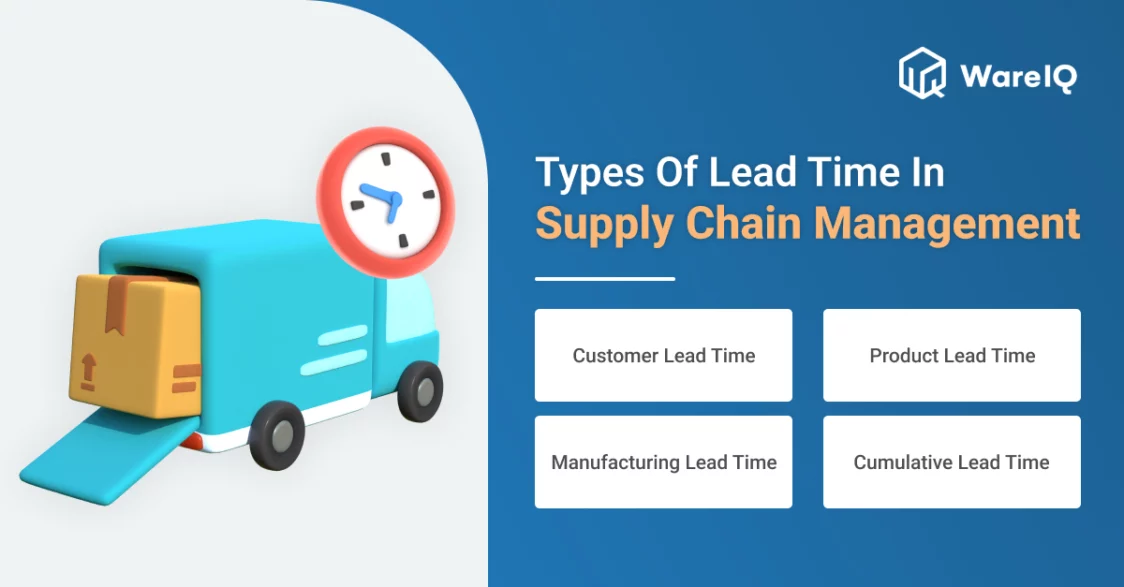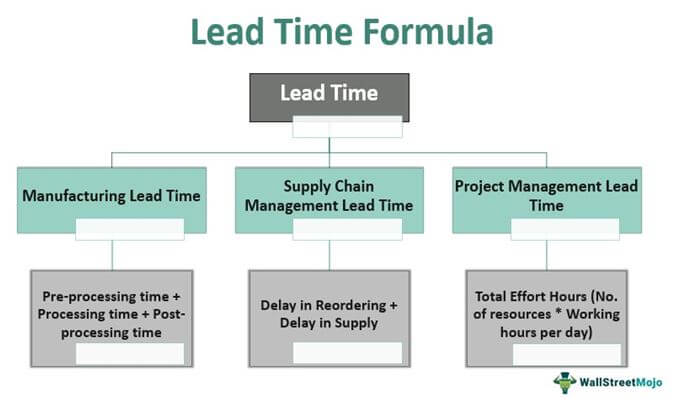A Detailed Guide on Lead Time in Supply Chain: Definition, Importance, Types, Lead Time Calculation, and Strategies To Reduce Lead Time in Logistics in 2025

The relevance of supply chain management has increased due to global trade growth. In 2020, the value of the global supply chain management market was estimated to be around 16 billion dollars. The procurement and supply chain management software market increased more than twofold during the previous ten years. The so-called global value chains (GVCs), which are the dominant mode of engagement in global economic relations, are made up of these networks of supply chains.
The growth of online retail has wholly changed how commerce is conducted. In particular, it has significantly increased client expectations, who now anticipate that orders will be delivered as quickly as possible. Retail enterprises face further obstacles as they compete in a highly cutthroat industry.
Effective inventory management and a seamless supply chain must be balanced. Retailers must ensure they have the right products, in the proper quantities, at the correct times. Inventory control can lead to catastrophes, including unfilled or missing client orders and delivery deadlines.
Because of this, it’s critical for merchants to employ the proper measures to guarantee that consumer orders take only a little time. One such indicator is the lead time in supply chain, which is crucial for general organizing reorders and inventory management.
In more detail, we’ll define lead time and outline its calculation in this guide. After that, we’ll get into why it matters, its potential impacts, and the factors that might impact it. Finally, we’ll wrap up by discussing how to reduce lead time in the supply chain for your company.
- What Is Lead Time In Supply Chain?
- What Is The Importance Of Lead Time In Logistics and Supply Chain?
- Types Of Lead Time In Supply Chain Management
- Lead Time vs Cycle Time vs Takt Time
- Factors That Affect Lead Time
- How Is Lead Time In Supply Chain Calculated?
- Why Lead Time Is Essential To Inventory Management and Impact of Shorter and Longer Lead Times On eCommerce Logistics?
- How To Reduce The Lead Time In Supply Chain?
- Conclusion
- With WareIQ, Inventory Management and Order Fulfilment Can Be Less Troublesome.
- Lead Time in Supply Chain: Frequently Asked Questions
What Is Lead Time In Supply Chain?
A crucial step in the supply chain process is lead time in supply chain management. It considers the time needed to place, process, produce, and deliver an order to the consumer. Supplier lead times, production times, and transit times are a few variables that might influence lead time in supply chain.
To control inventory levels, manufacturing schedules, and customer satisfaction, businesses must manage lead time in eCommerce logistics. Long lead times might result in excess inventory that locks up expensive resources and stockouts that can result in lost revenue. In addition, inefficient manufacturing and missed opportunities might occur from long lead periods that cause schedule delays in the production process.
What Is The Importance Of Lead Time In Logistics and Supply Chain?
In many sectors, lead time is a crucial statistic. To prevent a supply delay, which could severely impact customer satisfaction, contractor dependencies, and cost efficiency, it is essential to calculate lead times accurately and consistently.
Here are the top 5 factors that make lead time in supply chain necessary:
Edge Over Competitors
A shorter lead time in logistics is nearly always more appealing to clients. For example, if a company provides next-day delivery, but another offers a lead time of three days, the former company will likely win the sale if all other factors are equal.
Customers place a high value on quick lead times, as seen by Amazon’s supremacy, which is all necessary to comprehend.
Cost Cutting
Similar to the preceding argument, this also dramatically impacts a company’s bottom line.
Downtime and waste all cost money, whether it’s the price of unsellable, rotten items or the cost of storage.
Increased profitability results from shorter lead times, and you can only shorten lead times after determining current lead times.
Consumer Contentment
This holds for both B2C and B2B companies. Customers and clients will generally be more satisfied with your services if they are supplied more quickly, regardless of the competitive advantage of giving better lead times.
Faster lead time in the supply chain will provide value by promoting client loyalty and enhancing future sales.
Suggested Read: What is Online Consumer Behaviour?
Increased Output
Lead time in supply chain can be operationally planned for minimal or zero downtime when they are precisely assessed and understood by all parties. This allows you to produce at a higher rate and satisfy customer demand to a higher standard.
Project Management Dependencies
Lead times are significant in project management when a particular task or assignment is necessary before the rest of the project can advance.
Because lead times directly impact inventory levels, production plans, and customer satisfaction, managing lead times is essential for businesses. Long lead time in logistics may result in excess inventory, a waste of crucial resources, and stockouts, which may result in a loss of sales. Additionally, long lead time in supply chain might cause manufacturing schedule delays, resulting in production inefficiencies and missed opportunities.
Types Of Lead Time In Supply Chain Management

There are many different kinds, primarily based on how a firm operates. However, there are four crucial types of lead times in the supply chain, for instance, for an eCommerce company and fulfillment center:
Customer Lead Time

It is the interval between the confirmation of an order and its eCommerce fulfillment.
Product Lead Time
After the buyer places an order, this is calculated. If you are out of stock, it takes time to place an order with a supplier until you receive it. Learn more on how to handle out-of-stock items.
Manufacturing Lead Time
When you have the product on hand, this time is calculated. It is the time required to pick & pack service, and ship services a product while all the necessary supplies are on hand.
Cumulative Lead Time
The total lead time in the supply chain for the manufacturer and the materials are shown here. From the time an order is verified until the product is delivered, that’s how long it would take overall.
Lead Time vs Cycle Time vs Takt Time
Cycle time and takt time are somewhat connected, although lead time in logistics differs in several ways.
Takt Time: This is the rate at which the production process must be finished to satisfy consumer demand.

Order Cycle time is the period required for the entire manufacturing process of a product.
Cycle time is based on the production process, whereas Takt time is based on client demand. As a result, constantly check that your cycle time corresponds to your optimum takt time. To accomplish this, you can make several modifications. Furthermore, it gives you a shorter lead time, which aids in meeting consumer needs.
Factors That Affect Lead Time

Even while supply chains have significantly improved in recent years, several issues can still result in extended lead time in supply chain.
Stockouts
Stockouts may impact your supply chain at any point. Your factory can only fulfil your order if it can obtain the raw ingredients required. This is especially true if the factory employs a just-in-time methodology and does not keep goods on hand that can be shipped immediately. Stockouts in your online store could happen due to miscalculating your lead time, which you’ll want to avoid at all costs.
Variability in Lead Time
Since lead time in supply chain differ amongst suppliers, estimating when your items will be delivered can take time. This will inevitably result in production delays. Consolidating suppliers will enable you to order everything you require for production at once, which will help you avoid this issue.
Delivery Delays
Several uncontrollable variables, such as human error and natural disasters, might delay transportation. Unfortunately, shipping delays cannot be avoided entirely. You can, however, always choose a 3PL that is proactive in identifying solutions to shipping problems.
Ineffective Inventory Control
You may easily manage your inventory using an inventory management system. With an effective inventory control system, you can quickly overcome reorder delays and protect your stock from loss, damage, or misplacement. A less effective system may result in a longer lead time in logistics. Employ automated inventory management software to reduce delays and speed up the order-fulfillment process.
Ineffective Internal Systems
If you have to build every part of your product, it takes longer to finish each order. To cut down on production time, think about outsourcing pre-assembly. You can decrease lead time by cutting back on production time.
How Is Lead Time In Supply Chain Calculated?
Fortunately, when you know what factors to consider within the company process you want to calculate lead time for, it is relatively easy to determine.
You must consider the three primary activities between order and fulfillment to determine the “overall” wait time for a specific transaction.
These three procedures are described as follows:
Time spent on procurement. The period needed to execute the administrative tasks associated with a new order (getting materials, assigning work, etc.).
After procurement is complete, manufacturing time is needed to complete a good to a ship-ready standard.
The time is taken to transport products from the warehouse to the destination.
The following formula can be utilized to determine the total lead time.
Lead time is generally equal to the sum of manufacturing, shipping, and procurement times.

How To Calculate Lead Time In Supply Chain?
Let’s use an example to demonstrate this concept.
After accounting for all the variables, supply chain management would calculate the overall lead time.
Assume you are a supplier of convenience goods to a tiny corner shop, and your client asks you for the total lead time for one inventory round.
Suppose the procurement time—the time it takes to obtain the wholesale supply and packing—is four days. In that case, the packaging duration is one day, and the shipping time is two days. The entire lead time would be computed as 3 + 1 + 2, which equals the total lead time of 7 days.
Why Lead Time Is Essential To Inventory Management and Impact of Shorter and Longer Lead Times On eCommerce Logistics?
Lead time in logistics is a crucial component of inventory control. Therefore, businesses must ensure they can manage lead time and grasp it. If not, there can be severe side effects and consequent customer delays.
If lead times spiral out of control, a vicious cycle can develop, with lead times worsening as the supply chain becomes clogged due to the rising demand for the product. In addition, lead times may deteriorate further due to prolonged customer delays.
Stocks running out and customers not being able to receive their orders are two consequences of poorly managed lead times. In addition, poor order management can seriously harm a company’s reputation and result in customers switching to rivals. Therefore, you must make every effort possible to control lead time in supply chain appropriately.
Impacts of Longer Lead Time
Workflow issues arise when suppliers need help delivering a purchase order on time and in the appropriate quantities. Customers may experience delays or unmet charges if firms have nothing but their current, on-hand stock to fulfil orders. Suppose this stock proves insufficient to meet customer demand once a new supply arrives.
The customer experience can be significantly impacted by lead time. With so many options available to them nowadays, customers can quickly move their business elsewhere if they have a negative experience with a retailer. They’re prone to look for alternatives if their orders are delayed or they need help locating what they’re looking for.
Additionally, as firms need to hold more inventory to be ready for demand, storage costs will likely increase if lead time in supply chain is consistently shorter. As a result, businesses will become less responsive, and product prices will rise. Introducing new products will also be more complex because moving old stock will be more challenging.
Impacts of Shorter Lead Time
Numerous advantages inevitably arise with a shorter lead time in logistics. Five of the most significant ones are listed below:
- At specific points along your supply chain, you can store less inventory. Inventory management can be optimized when material and production lead times are shortened.
- You have more flexibility when there are abrupt changes in the market because of a shorter overall lead time.
- You might also find yourself with additional cash for your company. The extra money might be used to increase your marketing budget or acquire more stock. The longer you have to use your available funds, the shorter the overall lead time will be. Additionally, this enables you to replenish inventory more quickly and stop losing revenue and clients.
- You may boost your sales and get a competitive edge with online customers by reducing the time from customer order to delivery. Your success in eCommerce may also be aided by cutting down on your overall lead time.
- By cutting the lead time in logistics, you may meet your production targets and have seasonal items prepared for customer demand.
Unfortunately, clients will only be happy with your overall service, no matter how high-quality your product is if it takes too long to reach them. Longer lead times can also result in wasteful resource consumption, increased expedition costs, and surplus inventory, which can drain your business’s finances. Therefore, your eCommerce success depends on reducing total lead time, especially order fulfilment time.
How To Reduce The Lead Time In Supply Chain?
Take precise measurements of all supply timings using ranges.
Measure All Supply Times Through Ranges With Accuracy
Isolating and identifying critical lead time in supply chain is the ideal starting point for lowering delivery times (e.g. manufacturing, transport, warehouse processing, etc.). Each supply time must be divided into smaller components to be understood and optimized.
The same principles serve as the basis for warehouse KPI measures. This work is frequently made easier by specialized software, which smoothly integrates data throughout the supply chain.
Analyze In-Depth The Intralogistics Processes and Subprocesses
Analyzing intralogistics-related procedures is crucial for identifying bottlenecks and flaws that impede the flow of commodities. When you examine the warehouse, you see that various sub-processes come together to form global operational management. And even the smallest detail can cause these flows to reverberate.
Imagine, for instance, that a roller conveyor is used to transfer goods according to the FIFO principle (first in, first out). At some point, the conveyor can no longer handle the flow, and boxes pile up next to the congested conveyor on the floor. They continue to be stacked on top of one another.
When the backlog on the opposite side of the circuit is reduced, and the conveyor reloads, operators will likely choose the top boxes first, switching the priority order to LIFO (last in, first out). And this is where an area of extreme inefficiency develops, lengthening operation times. To identify and address the problem’s core cause, careful warehouse flow analysis is required.
Utilize Specialist Software To Manage Uncertainties
Various factors can cause variations in supply times. Numerous of them are arbitrary and unanticipated. Specialized logistics software in this regard aids in reducing this unpredictability and enhancing lead time.
Enhancing your capacity to respond to unforeseen circumstances. In a warehouse setting, this has a different meaning. How should I respond to an unexpected stock arrival or blind reception? What logistics guidelines should order picking adhere to?
A warehouse management system can immediately address these problems and many others.
All the data in your supply chain will be integrated and unified, facilitating decision-making and identifying hot spots throughout the supply chain.
Make Contractual Arrangements With Vendors
The preference is to prioritize long-term partnerships when choosing suppliers. This is due to the ability to standardize procedures and hone supply timetables. They can be condensed to use just-in-time scheduling or cross-docking.
WMS Software makes it easier for warehouses to integrate with the major transportation companies, which is crucial for the logistics of eCommerce, among other industries.
The warehouse serves as a crucial link between supply and demand and forms the foundation of the entire supply chain. So, optimizing warehouse management is essential to cutting down on lead time in logistics.
Conclusion
Sharper lead time in the supply chain cannot be avoided in the current business environment. Additionally, there is a growing need for quicker fulfillment by teams, enterprises, and customers.
Having stated that, each company is distinct. Additionally, you should create a lead time management strategy that supports your team’s unique procedures and commitments.
Take advantage of intelligent project management systems’ opportunities for increasing efficiency. Create logical lead time dashboards, integrate your tools, and set up automation to handle the laborious lead time computation and even reordering on your behalf.
With WareIQ, Inventory Management and Order Fulfilment Can Be Less Troublesome.
It is challenging to manage and identify a long lead time in supply chain since reducing lead times involves many moving elements.
WareIQ collaborates with you to give access to a countrywide omnichannel fulfilment network, including 2-day shipping with 98% coverage in the country so that you can concentrate on customer happiness, product development, and overall business success.
When you work with WareIQ, you can quickly cut lead time in logistics by letting the professionals handle your inventory management, fulfilment, and shipping needs (in addition to other value-added services like WareIQ Rush).
Real-time inventory tracking is a feature of WareIQ’s fulfilment platform, allowing you to always know precisely how much and where you have in stock. Additionally, you may establish reorder point notifications, which ensures that you’ll always replace your inventory at the appropriate moment and avoid stockouts.
WareIQ handles everything from inventory distribution to warehouse receiving to shipping and fulfilment, so you can concentrate on expanding your business.









